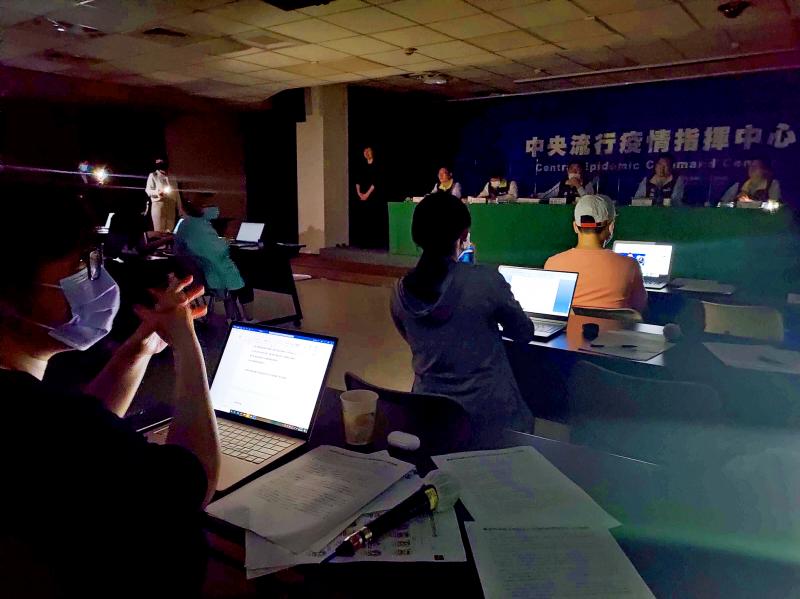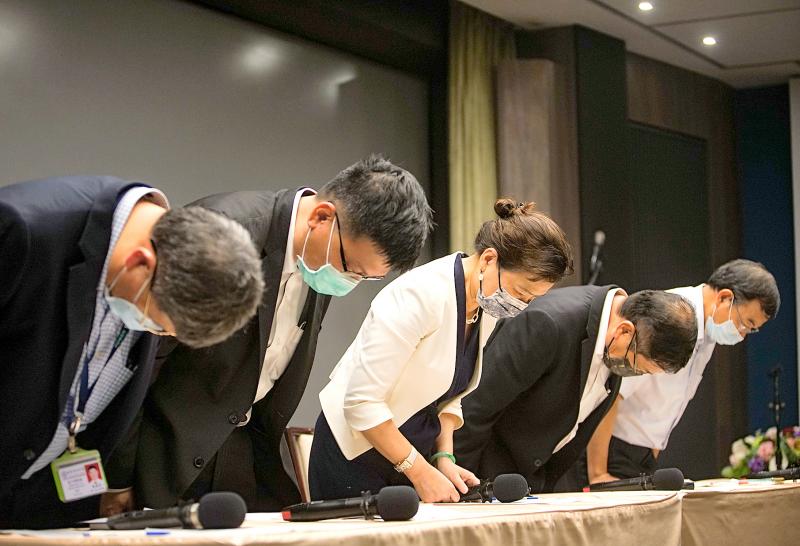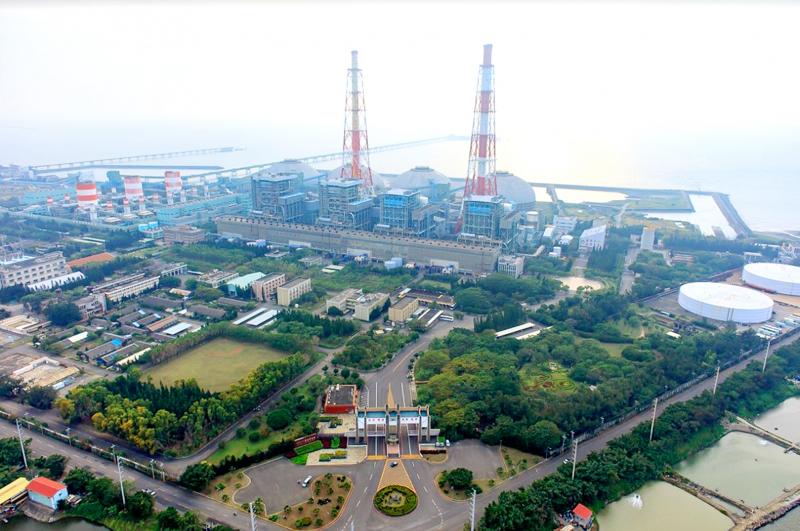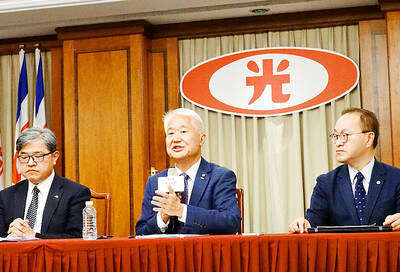There were rolling blackouts across Taiwan yesterday due to a grid malfunction at the Hsinta Power Plant (興達電廠) in Kaohsiung’s Yongan District (永安), while Taiwan Power Co (Taipower, 台電) said that it was working “as hard as possible to resolve the issue as soon as possible.”
At 2:37pm, a malfunction at an ultra-high-voltage substation in Kaohsiung’s Lujhu District (路竹) triggered four generators at the Hsinta plant to go offline, cutting power output by 2.2 million kilowatts and prompting Taipower to initiate rolling blackouts nationwide as it worked on the problem.
Taipower spokesman Chang Ting-shu (張廷抒) told a news conference in Taipei that the blackouts were not due to power usage exceeding supply, but a grid problem.

Photo: Wu Liang-yi, Taipei Times
“Rumors that we ran out of power or something went wrong with the Hsinta plant are false” Chang said. “This is a grid malfunction.”
A bus, or connection feeder, had failed at the Lujhu substation, which caused the voltage to drop precipitously, Chang said.
As emergency controls kicked in, two coal-fired generators and two liquified natural gas generators were shut down at the Hsinta plant, he said.

Photo: CNA
The exact cause of the bus failure remains unknown, Chang said.
The rolling blackouts were implemented at 50-minute intervals, affecting 4 million customers in total, with the goal of having power fully restored sometime yesterday evening, Taipower said.
Later, it said that electricity was restored ahead of schedule at 8pm and no more blackouts were expected.

Photo: Chen Wen-chan, Taipei Times
The first round of outages reduced total output by 3 million kilowatts between 3pm and 3:50pm.
The second round cut output by 3 million kilowatts between 3:50pm and 4:40pm, it said.
The third round reduced output by 3.5 million kilowatts between 4:40pm and 5:30pm; the fourth round was from 5:30pm to 6:20pm; the fifth round was from 6:20pm to 7:10pm, and the sixth was from 7:10pm to 8pm, Taipower said.
Minister of Economic Affairs Wang Mei-hua (王美花) apologized to the nation later yesterday and said that power would be fully restored by 9:40pm.
Idle power generators were brought online in an attempt to fill the gap left by the Singda outages, Chang said.
“We are working to make sure this is resolved overnight,” he said. “Once we fix the grid, we can bring the Singda generators back online.”
The last major power outage in Taiwan, on Aug. 15, 2017, was caused by a natural gas supply disruption at the Datan Power Plant (大潭電廠) in Taoyuan.
It shut down, eliminating 4.7 million kilowatts of power supply.
Half of Taiwan lost power on a rotational basis for at least three hours, affecting many science parks.
Some of Taiwan Semiconductor Manufacturing Co’s (TSMC, 台積電) facilities reported brief power dips yesterday, but the power supply is currently normal, the company said in a statement.
“The electricity is being supplied as normal,” it said. “TSMC has taken emergency response measures and prepared generators to minimize potential impact.”
Operations at ASE Technology Holding Co (日月光投控), the world’s largest chip packaging and testing services provider, had been affected, the company said in a text message, but the full impact was yet to be determined.
Additional reporting by Lisa Wang

People can preregister to receive their NT$10,000 (US$325) cash distributed from the central government on Nov. 5 after President William Lai (賴清德) yesterday signed the Special Budget for Strengthening Economic, Social and National Security Resilience, the Executive Yuan told a news conference last night. The special budget, passed by the Legislative Yuan on Friday last week with a cash handout budget of NT$236 billion, was officially submitted to the Executive Yuan and the Presidential Office yesterday afternoon. People can register through the official Web site at https://10000.gov.tw to have the funds deposited into their bank accounts, withdraw the funds at automated teller

PEACE AND STABILITY: Maintaining the cross-strait ‘status quo’ has long been the government’s position, the Ministry of Foreign Affairs said Taiwan is committed to maintaining the cross-strait “status quo” and seeks no escalation of tensions, the Ministry of Foreign Affairs (MOFA) said yesterday, rebutting a Time magazine opinion piece that described President William Lai (賴清德) as a “reckless leader.” The article, titled “The US Must Beware of Taiwan’s Reckless Leader,” was written by Lyle Goldstein, director of the Asia Program at the Washington-based Defense Priorities think tank. Goldstein wrote that Taiwan is “the world’s most dangerous flashpoint” amid ongoing conflicts in the Middle East and Russia’s invasion of Ukraine. He said that the situation in the Taiwan Strait has become less stable

CONCESSION: A Shin Kong official said that the firm was ‘willing to contribute’ to the nation, as the move would enable Nvidia Crop to build its headquarters in Taiwan Shin Kong Life Insurance Co (新光人壽) yesterday said it would relinquish land-use rights, or known as surface rights, for two plots in Taipei’s Beitou District (北投), paving the way for Nvidia Corp to expand its office footprint in Taiwan. The insurer said it made the decision “in the interest of the nation’s greater good” and would not seek compensation from taxpayers for potential future losses, calling the move a gesture to resolve a months-long impasse among the insurer, the Taipei City Government and the US chip giant. “The decision was made on the condition that the Taipei City Government reimburses the related

FRESH LOOK: A committee would gather expert and public input on the themes and visual motifs that would appear on the notes, the central bank governor said The central bank has launched a comprehensive redesign of New Taiwan dollar banknotes to enhance anti-counterfeiting measures, improve accessibility and align the bills with global sustainability standards, Governor Yang Chin-long (楊金龍) told a meeting of the legislature’s Finance Committee yesterday. The overhaul would affect all five denominations — NT$100, NT$200, NT$500, NT$1,000 and NT$2,000 notes — but not coins, Yang said. It would be the first major update to the banknotes in 24 years, as the current series, introduced in 2001, has remained in circulation amid rapid advances in printing technology and security standards. “Updating the notes is essential to safeguard the integrity